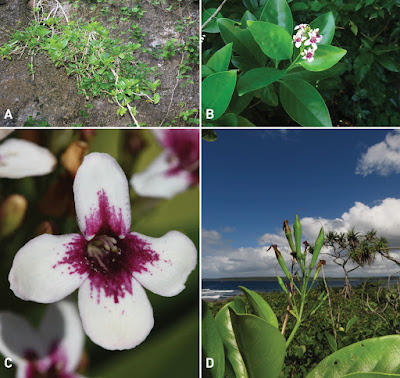 |
| Pseuderanthemum melanesicum Gâteblé, Ramon & Butaud
in Gâteblé, Ramon & Butaud, 2019.
84. DOI: 10.3897/phytokeys.128.36325
|
Abstract
When dealing with the taxonomy of Pacific coastal species within the region of New Caledonia and Vanuatu, one should examine all names published in Australasia and other Pacific islands. When the putative new species is also closely related to a highly praised ornamental species with many cultigens and with many old horticultural names, the task becomes more arduous. This is the case for the new species we describe as Pseuderanthemum melanesicum Gâteblé, Ramon & Butaud, which is closely related to the now pantropical cultivated species P. carruthersii (Seem.) Guillaumin s.l. Compared to P. carruthersii, P. melanesicum has carnose and shiny leaves, pedicels and sepals covered with glandular hairs, a short and enlarged corolla tube and can produce fertile capsules. The new species is a coastal taxon occurring naturally in the Melanesian archipelagos of New Caledonia and Vanuatu. This species seems uncommon in the Loyalty Islands but more common in the archipelago of Vanuatu and we propose it as Critically Endangered in New Caledonia, Vulnerable in Vanuatu and Least Concern when the IUCN evaluation is done globally.
Keywords: Acanthaceae, New Caledonia, new species, Pseuderanthemum, taxonomy, Vanuatu
Pseuderanthemum melanesicum Gâteblé, Ramon & Butaud, sp. nov.
Diagnosis: Pseuderanthemum melanesicum Gâteblé, Ramon & Butaud is most similar to some cultigens of P. carruthersii but differs from them by its carnose leaf texture vs. chartaceous, by its pedicels and sepals with glandular hairs vs. eglandular hairs, by its glabrous petals and tube vs. hairy petals and tube and by its short and enlarged corolla tube vs. longer cylindrical corolla tube.
...
Etymology: The new species is named after the Melanesian archipelagos of New Caledonia and Vanuatu.
Species recognition: With its carnose and shiny leaves (especially seen on fresh material), its short and broaden corolla tube and its many glandular hairs on pedicels and sepals, P. melanesicum is easily separated from the cultivated, widespread and variable taxon, P. carruthersii. In addition, in both countries the new species has been collected in fruit while there is, to our knowledge, no fruiting specimen of P. carruthersii in the region. The well-known south-western Pacific botanical specialist Peter Shaw Green (1920–2009) also thought it was a putative new species as he wrote “Pseuderanthemum sp.? ined” on several herbarium sheets (e.g., Hallé 6331 and Gillison 3539).
Notes:
Color figures of P. melanesicum have already been published twice under misapplied names of other species inhabiting Loyalty Islands and Vanuatu, once as P. repandum (G.Forst.) Guillaumin subsp. loyaltyensis (Guillaumin) Heine or «Waditcha» in Suprin (2008: 177), and the other one (fig. 119a) as P. carruthersii in Ramon and Sam (2015: 121). The vernacular name Watija in Maré can be related to P. repandum subsp. loyaltyensis but this name was not recorded recently (Lormée et al. 2011) for that species; Watija is clearly the local name of Psychotria nummularioides Baill. ex Guillaumin and has also been given to Cleidion verticillatum Baill., a shrub of the same size (Butaud, pers. obs.). Two local names are reported on Gillison 3539 for Vanuatu as Nuguvere and Malandi. According to Gâteblé et al. (2018), P. melanesicum is only the third non-endemic species described from New Caledonia since the beginning of the 21st Century. Pseuderanthemum melanesicum is easily propagated by cuttings and it thrives well in cultivation. Even in cultivation, the carnose and shiny leaves are maintained (Fig. 3) and it makes a nice native ornamental plant for gardens and landscaping in open or shaded areas.
The cultivated plant from which the type specimen was prepared was originally collected by J.-F. Butaud on Lifou, north of Wé to Luecila, (2 m elevation, ...E) on 19 April 2014.
Distribution and ecology: In New Caledonia and Vanuatu, P. melanesicum is found in coastal thickets on limestone substrate, either coastal reef, cliffs or back of the beaches, with species of Bikkia Reinw. ex Blume, Dendrolobium (Wight & Arn.) Benth., Eugenia P.Micheli ex L., Heliotropium Tourn. ex L., Hibiscus L., Myoporum Banks & Sol. ex G.Forst., Nicotiana L., Pemphis J.R.Forst. & G.Forst., Sarcolobus R.Br. and Xylosma G.Forst. at 2–60 m elevation in the Loyalty Islands. In New Caledonia, it is only known from Lifou and Maré in the Loyalty Islands and it is known from Efaté and Malakula in Vanuatu (Fig. 1). With such a distribution, the species should be more common than reflected by the available herbarium specimens. Recently (February 2019) the species was seen in relatively large populations on Erakor Island (Port Vila) and Port Resolution (Tanna). Like in other Acanthaceae, P. melanesicum seeds are dispersed through ballochory that could explain the many individuals found in some populations in Vanuatu. The seed seems also able to float on sea water for a few hours (observation made with only one seed).
Gildas Gâteblé, Laurence Ramon and Jean-François Butaud. 2019. A New Coastal Species of Pseuderanthemum (Acanthaceae) from Loyalty Islands (New Caledonia) and Vanuatu with Notes on P. carruthersii. PhytoKeys. 128: 73-84. DOI: 10.3897/phytokeys.128.36325




